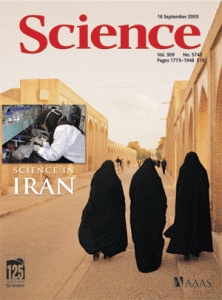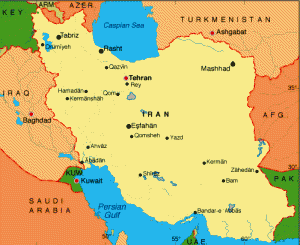George Jones, past President of the Royal Society’s Wellington branch, recently visited Iran and was given an insight into the Iranian approach to science and technology. He filed this report.
 The Technology Coordination Office is an umbrella organisation at the highest level of Iran’s government, advising the President about science and technology and coordinating, educating, mentoring and training the S&T community. See www.tco.ir . Its closest equivalent in New Zealand is the Royal Society of NZ, except for ownership. In New Zealand we tend to use ‘science’ as the word to describe both S&T, while in Iran they use ‘technology’ to mean the same thing.
The Technology Coordination Office is an umbrella organisation at the highest level of Iran’s government, advising the President about science and technology and coordinating, educating, mentoring and training the S&T community. See www.tco.ir . Its closest equivalent in New Zealand is the Royal Society of NZ, except for ownership. In New Zealand we tend to use ‘science’ as the word to describe both S&T, while in Iran they use ‘technology’ to mean the same thing.
I was invited to see if there could be stronger collaborative links between researchers in both countries, as well as seeing if some of their technology could be of use here in New Zealand, and vice versa.
At all times I had a driver and a guide, so that they could efficiently use my time. I had been asked to limit my interest to only one subject, so they could aim efficiently, so I looked at what they had decided to specialise in. They have four major areas of specialisation: energy, biotechnology, nanotechnology, and information and communication technology. I chose nanotechnology as a young, fast expanding and exciting area of research.
In 2001 they decided to push for excellence in nanotech, and are proud of their progress. See www.en.nano.ir . They are now 19th in the world ranking, and aspire to be 15th.
They have about 2000 masterate and 400 doctorate researchers in nanotech, about 2% and 0.7% of the student population at those levels. Nearly two thirds of the students entering university are women, with a similar fraction in science and technology. The population is generally young, with half of the 71 million under 35.
The country has been suffering from three decades under US sanctions, so they have been limited in acquiring appropriate tools for their work. However they are relatively pleased that the sanctions are there, as it forced them to stand on their own feet, in a similar way that UK’s entry into the EU forced us in NZ to learn to market to the world, and again when our farmers lost their government subsidies, forcing us to be competitive on an uneven playing field. Because their banking system is not connected internationally, the recent downturn in the world’s finances has not so far had any effect in Iran.
So they have developed their own tools, and they are ready to market these to the world, at a better price because of their lower wages structure. I saw a scanning tunnelling electron microscope that they are using for medical research. They are working on early detection of cancers, and are proud that they can detect 2 mm cancerous lumps, by attaching iron oxide nanoparticles to the cancer cells. I also saw a computer-controlled machine for spraying nanofibres on to targets using a high voltage, similar to applying powder coating paints.
 I was also shown around the Pardis Technology Park ( www.hitechpark.com ) about 25 km east of Tehran, where there are many buildings being built, a few occupied. The first companies to arrive are the already established ones, and soon the new startups will come, nurtured by a well organised support system to train technologists to be businessmen and women, and to provide appropriate venture capital, administrative and mentoring backup.
I was also shown around the Pardis Technology Park ( www.hitechpark.com ) about 25 km east of Tehran, where there are many buildings being built, a few occupied. The first companies to arrive are the already established ones, and soon the new startups will come, nurtured by a well organised support system to train technologists to be businessmen and women, and to provide appropriate venture capital, administrative and mentoring backup.
They have a Scientists Garden in the park, with so far only one scientist’s bronze statue installed. It is of the Armenian astrophysicist, Victor Hambartsumyan. Soon to be displayed will be an Iranian, and an American scientist. There are three names proposed to represent New Zealand, and the decision on which one to display has not yet been made.
They call the park Paradise, but at the moment it, like much of Tehran, looks more like a construction site. There is plenty of room for expansion in the current 20 hectares, with a second section of 18 ha, and a total reserve of 1000 ha (10 square kilometres).
This is all to turn around their country that had the largest brain drain in the world, with more Iranians in California than anywhere else. There are 10 000 in NZ.
They also showed me some of the tourist sites, including a fabulous museum of jewelery, several palaces occupied by the shars until they kicked the last one out in 1979, the modest home of Imam (Ayatullah) Khomeini, close to the home of New Zealand’s Ambassador. I spent a very long day being shown around the old city of Esfahan, on the public holiday commemorating Mohammed’s birthday.
There are road rules in Tehran, but generally drivers take no notice of them, especially in the central city. Each driver knows accurately the dimensions of his vehicle, and allows perhaps a couple of hundred millimetres between wing mirrors. Motor cycles also weave in and out, sometimes travelling on the wrong side of the road to pass. So a two lane highway may have three or four cars abreast, maybe with a motor cyclist as well. A light beep on the horn to signify “I’m coming through”. All very matter-of-fact with nobody getting upset. It is even worse as a pedestrian, though I found that exactly following the locals’ movements to negotiate through the cars did the trick.
The city of Tehran is surrounded by mountains, so the 10 million people have to suffer a high atmospheric pollution level. It snowed lightly once when I was there, and as the snowflakes melted, there were splotches of grey over everything.
They are building an underground railway to try to take some pressure off the traffic chaos, and reduce pollution.
I learned a few things from various conversations, so more opinions than hard facts.
The food taste sensations are wonderful. Lots of kebabs, rice, fish. The locals drink a non-alcoholic beer, but I stuck to the yoghurt drink generally.
Women are comforted because they are valued for their abilities, not because they are women, as their religion states that they cover up everything except their faces when in public. But some young women are showing some of their hair, so small changes are happening.
There is to be a presidential election in June, and it is considered that when President Ahmadinejad is voted out, there may be room for a thawing of US relations through President Obama.
Science and especially evolution sits comfortably with the Islamic religion, as one of the tenets is ‘go out and discover things’.
They are angry that some violent people have latched onto the side of their religion to gain legitimacy. There is a parallel with pseudo-science latching onto science for the same reason.
There is a considerable enthusiasm for the future of their country. They are rapidly increasing their knowledge and skills, proud of their achievements, like sending up a satellite, refining their uranium ore, building their own tools, feeding their own people. They are proud of their history, proud of their religion that is as well a way of life, a political system and a set of laws.
They are proud of the fact that they kicked out a system of government that concentrated vast wealth and (often cruel) power in one man, and replaced it with a democracy.